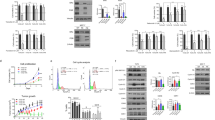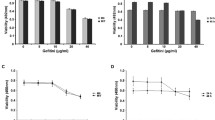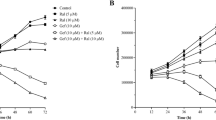Abstract
Resistance to tamoxifen is a major clinical challenge in the treatment of breast cancer; however, it is still unclear which signaling pathways are the major drivers of tamoxifen-resistant growth. To characterize resistance mechanisms, we have generated different tamoxifen-resistant breast cancer cell lines from MCF-7. In this model, we investigated whether signaling from human epidermal growth factor receptors (HERs), their downstream kinases, or from the estrogen receptor α (ERα) was driving tamoxifen-resistant cell growth. Increased expression of EGFR and increased phosphorylation of HER3 were observed upon acquisition of tamoxifen resistance, and the extracellular activated kinase (ERK) signaling pathway was highly activated in the resistant cells. The EGFR inhibitor gefitinib and the ERK pathway inhibitor U0126 resulted in partial and preferential growth inhibition of tamoxifen-resistant cells. All the tamoxifen-resistant cell lines retained ERα expression but at a lower level compared to that in MCF-7. Importantly, we showed via ERα knockdown that the tamoxifen-resistant cells were dependent on functional ERα for growth and we observed a clear growth stimulation of resistant cell lines with clinically relevant concentrations of tamoxifen and 4-OH-tamoxifen, indicating that tamoxifen-resistant cells utilize agonistic ERα stimulation by tamoxifen for growth. The tamoxifen-resistant cells displayed high phosphorylation of ERα at Ser118 in the presence of tamoxifen; however, treatment with U0126 neither affected the level of Ser118 phosphorylation nor expression of the ERα target Bcl-2, suggesting that ERK contributes to cell growth independently of ERα in our cell model. In support of this, combined treatment against ERα and ERK signaling in resistant cells was superior to single-agent treatment and as effective as fulvestrant treatment of MCF-7 cells. Together, these findings demonstrate that ERα is a major driver of growth in tamoxifen-resistant cells supported by HER/ERK growth signaling, implying that combined targeting of these pathways may have a clinical potential for overcoming tamoxifen resistance.






Similar content being viewed by others
References
Davies C, Godwin J, Gray R, Clarke M, Cutter D, Darby S, McGale P, Pan HC, Taylor C, Wang YC, Dowsett M, Ingle J, Peto R (2011) Relevance of breast cancer hormone receptors and other factors to the efficacy of adjuvant tamoxifen: patient-level meta-analysis of randomised trials. Lancet 378(9793):771–784
Benz CC, Scott GK, Sarup JC, Johnson RM, Tripathy D, Coronado E, Shepard HM, Osborne CK (1992) Estrogen-dependent, tamoxifen-resistant tumorigenic growth of MCF-7 cells transfected with HER2/neu. Breast Cancer Res Treat 24(2):85–95
Knowlden JM, Hutcheson IR, Jones HE, Madden T, Gee JM, Harper ME, Barrow D, Wakeling AE, Nicholson RI (2003) Elevated levels of epidermal growth factor receptor/c-erbB2 heterodimers mediate an autocrine growth regulatory pathway in tamoxifen-resistant MCF-7 cells. Endocrinology 144(3):1032–1044
Frogne T, Benjaminsen RV, Sonne-Hansen K, Sorensen BS, Nexo E, Laenkholm AV, Rasmussen LM, Riese DJ 2nd, de Cremoux P, Stenvang J, Lykkesfeldt AE (2009) Activation of ErbB3, EGFR and Erk is essential for growth of human breast cancer cell lines with acquired resistance to fulvestrant. Breast Cancer Res Treat 114(2):263–275
Rasmussen BB, Regan MM, Lykkesfeldt AE, Dell’Orto P, Del Curto B, Henriksen KL, Mastropasqua MG, Price KN, Mery E, Lacroix-Triki M, Braye S, Altermatt HJ, Gelber RD, Castiglione-Gertsch M, Goldhirsch A, Gusterson BA, Thurlimann B, Coates AS, Viale G (2008) Adjuvant letrozole versus tamoxifen according to centrally-assessed ERBB2 status for postmenopausal women with endocrine-responsive early breast cancer: supplementary results from the BIG 1–98 randomised trial. Lancet Oncol 9(1):23–28
Nahta R, O’Regan RM (2012) Therapeutic implications of estrogen receptor signaling in HER2-positive breast cancers. Breast Cancer Res Treat 135(1):39–48
Frogne T, Laenkholm AV, Lyng MB, Henriksen KL, Lykkesfeldt AE (2009) Determination of HER2 phosphorylation at tyrosine 1221/1222 improves prediction of poor survival for breast cancer patients with hormone receptor-positive tumors. Breast Cancer Res 11(1):R11
Gee JM, Robertson JF, Ellis IO, Nicholson RI (2001) Phosphorylation of ERK1/2 mitogen-activated protein kinase is associated with poor response to anti-hormonal therapy and decreased patient survival in clinical breast cancer. Int J Cancer 95(4):247–254
Musgrove EA, Sutherland RL (2009) Biological determinants of endocrine resistance in breast cancer. Nat Rev Cancer 9(9):631–643
Yde CW, Emdal KB, Guerra B, Lykkesfeldt AE (2012) NFkappaB signaling is important for growth of antiestrogen resistant breast cancer cells. Breast Cancer Res Treat 135(1):67–78
Johnston SR (2010) New strategies in estrogen receptor-positive breast cancer. Clin Cancer Res 16(7):1979–1987
Osborne CK, Shou J, Massarweh S, Schiff R (2005) Crosstalk between estrogen receptor and growth factor receptor pathways as a cause for endocrine therapy resistance in breast cancer. Clin Cancer Res 11(2 Pt 2):865s–870s
Kato S, Endoh H, Masuhiro Y, Kitamoto T, Uchiyama S, Sasaki H, Masushige S, Gotoh Y, Nishida E, Kawashima H, Metzger D, Chambon P (1995) Activation of the estrogen receptor through phosphorylation by mitogen-activated protein kinase. Science 270(5241):1491–1494
Briand P, Lykkesfeldt AE (1984) Effect of estrogen and antiestrogen on the human breast cancer cell line MCF-7 adapted to growth at low serum concentration. Cancer Res 44(3):1114–1119
Lykkesfeldt AE, Madsen MW, Briand P (1994) Altered expression of estrogen-regulated genes in a tamoxifen-resistant and ICI 164,384 and ICI 182,780 sensitive human breast cancer cell line, MCF-7/TAMR-1. Cancer Res 54(6):1587–1595
Lundholt BK, Briand P, Lykkesfeldt AE (2001) Growth inhibition and growth stimulation by estradiol of estrogen receptor transfected human breast epithelial cell lines involve different pathways. Breast Cancer Res Treat 67(3):199–214
Sonne-Hansen K, Norrie IC, Emdal KB, Benjaminsen RV, Frogne T, Christiansen IJ, Kirkegaard T, Lykkesfeldt AE (2010) Breast cancer cells can switch between estrogen receptor alpha and ErbB signaling and combined treatment against both signaling pathways postpones development of resistance. Breast Cancer Res Treat 121(3):601–613
Larsen MS, Yde CW, Christensen IJ, Lykkesfeldt AE (2012) Carboplatin treatment of antiestrogen-resistant breast cancer cells. Int J Oncol 41(5):1863–1870
Memon AA, Sorensen BS, Melgard P, Fokdal L, Thykjaer T, Nexo E (2004) Expression of HER3, HER4 and their ligand heregulin-4 is associated with better survival in bladder cancer patients. Br J Cancer 91(12):2034–2041
Moulder SL, Yakes FM, Muthuswamy SK, Bianco R, Simpson JF, Arteaga CL (2001) Epidermal growth factor receptor (HER1) tyrosine kinase inhibitor ZD1839 (Iressa) inhibits HER2/neu (erbB2)-overexpressing breast cancer cells in vitro and in vivo. Cancer Res 61(24):8887–8895
Osborne CK, Schiff R (2011) Mechanisms of endocrine resistance in breast cancer. Annu Rev Med 62:233–247
Ali S, Coombes RC (2002) Endocrine-responsive breast cancer and strategies for combating resistance. Nat Rev Cancer 2(2):101–112
Howell A, Robertson J (1995) Response to a specific antioestrogen (ICI 182780) in tamoxifen-resistant breast cancer. Lancet 345(8955):989–990
Nicholson RI, Johnston SR (2005) Endocrine therapy–current benefits and limitations. Breast Cancer Res Treat 93(Suppl 1):S3–S10
Hutcheson IR, Knowlden JM, Madden TA, Barrow D, Gee JM, Wakeling AE, Nicholson RI (2003) Oestrogen receptor-mediated modulation of the EGFR/MAPK pathway in tamoxifen-resistant MCF-7 cells. Breast Cancer Res Treat 81(1):81–93
Arnold SF, Obourn JD, Jaffe H, Notides AC (1995) Phosphorylation of the human estrogen receptor by mitogen-activated protein kinase and casein kinase II: consequence on DNA binding. J Steroid Biochem Mol Biol 55(2):163–172
Chen D, Riedl T, Washbrook E, Pace PE, Coombes RC, Egly JM, Ali S (2000) Activation of estrogen receptor alpha by S118 phosphorylation involves a ligand-dependent interaction with TFIIH and participation of CDK7. Mol Cell 6(1):127–137
Cutrupi S, Reineri S, Panetto A, Grosso E, Caizzi L, Ricci L, Friard O, Agati S, Scatolini M, Chiorino G, Lykkesfeldt AE, De Bortoli M (2012) Targeting of the adaptor protein Tab 2 as a novel approach to revert tamoxifen resistance in breast cancer cells. Oncogene 31(40):4353–4361
Perissi V, Jepsen K, Glass CK, Rosenfeld MG (2010) Deconstructing repression: evolving models of co-repressor action. Nat Rev Genet 11(2):109–123
Acknowledgments
We thank Jane Lind Christensen for excellent technical assistance. This study was supported by grants from the Danish Medical Research Council (271-07-0704), Danish Cancer Society (R38-A1682), A Race Against Breast Cancer, and Balslev Foundation.
Conflict of interest
The authors declare that they have no conflict of interests.
Author information
Authors and Affiliations
Corresponding author
Rights and permissions
About this article
Cite this article
Thrane, S., Lykkesfeldt, A.E., Larsen, M.S. et al. Estrogen receptor α is the major driving factor for growth in tamoxifen-resistant breast cancer and supported by HER/ERK signaling. Breast Cancer Res Treat 139, 71–80 (2013). https://doi.org/10.1007/s10549-013-2485-2
Received:
Accepted:
Published:
Issue Date:
DOI: https://doi.org/10.1007/s10549-013-2485-2




